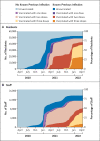Protection against Omicron from Vaccination and Previous Infection in a Prison System
- PMID: 36286260
- PMCID: PMC9634863
- DOI: 10.1056/NEJMoa2207082
Protection against Omicron from Vaccination and Previous Infection in a Prison System
Abstract
Background: Information regarding the protection conferred by vaccination and previous infection against infection with the B.1.1.529 (omicron) variant of severe acute respiratory syndrome coronavirus 2 (SARS-CoV-2) is limited.
Methods: We evaluated the protection conferred by mRNA vaccines and previous infection against infection with the omicron variant in two high-risk populations: residents and staff in the California state prison system. We used a retrospective cohort design to analyze the risk of infection during the omicron wave using data collected from December 24, 2021, through April 14, 2022. Weighted Cox models were used to compare the effectiveness (measured as 1 minus the hazard ratio) of vaccination and previous infection across combinations of vaccination history (stratified according to the number of mRNA doses received) and infection history (none or infection before or during the period of B.1.617.2 [delta]-variant predominance). A secondary analysis used a rolling matched-cohort design to evaluate the effectiveness of three vaccine doses as compared with two doses.
Results: Among 59,794 residents and 16,572 staff, the estimated effectiveness of previous infection against omicron infection among unvaccinated persons who had been infected before or during the period of delta predominance ranged from 16.3% (95% confidence interval [CI], 8.1 to 23.7) to 48.9% (95% CI, 41.6 to 55.3). Depending on previous infection status, the estimated effectiveness of vaccination (relative to being unvaccinated and without previous documented infection) ranged from 18.6% (95% CI, 7.7 to 28.1) to 83.2% (95% CI, 77.7 to 87.4) with two vaccine doses and from 40.9% (95% CI, 31.9 to 48.7) to 87.9% (95% CI, 76.0 to 93.9) with three vaccine doses. Incremental effectiveness estimates of a third (booster) dose (relative to two doses) ranged from 25.0% (95% CI, 16.6 to 32.5) to 57.9% (95% CI, 48.4 to 65.7) among persons who either had not had previous documented infection or had been infected before the period of delta predominance.
Conclusions: Our findings in two high-risk populations suggest that mRNA vaccination and previous infection were effective against omicron infection, with lower estimates among those infected before the period of delta predominance. Three vaccine doses offered significantly more protection than two doses, including among previously infected persons.
Copyright © 2022 Massachusetts Medical Society.
Figures




Update of
-
Protection against Omicron conferred by mRNA primary vaccine series, boosters, and prior infection.medRxiv [Preprint]. 2022 May 27:2022.05.26.22275639. doi: 10.1101/2022.05.26.22275639. medRxiv. 2022. Update in: N Engl J Med. 2022 Nov 10;387(19):1770-1782. doi: 10.1056/NEJMoa2207082. PMID: 35665013 Free PMC article. Updated. Preprint.
Comment in
-
Protection against Omicron from Vaccination and Previous Infection.N Engl J Med. 2023 Jan 5;388(1):95-96. doi: 10.1056/NEJMc2214627. Epub 2022 Dec 21. N Engl J Med. 2023. PMID: 36546675 No abstract available.
-
Protection against Omicron from Vaccination and Previous Infection. Reply.N Engl J Med. 2023 Jan 5;388(1):96. doi: 10.1056/NEJMc2214627. Epub 2022 Dec 21. N Engl J Med. 2023. PMID: 36546676 No abstract available.
References
Publication types
MeSH terms
Substances
Supplementary concepts
Grants and funding
LinkOut - more resources
Full Text Sources
Medical
Miscellaneous
